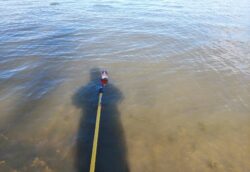By Garret Homer, University of Idaho, winner of WALPA 2023 Undergraduate Scholarship
Cultural eutrophication is a topic on the minds of many lake management professionals and researchers because it is a near-ubiquitous issue in lakes with or surrounded by human activities. For my senior thesis in the Ecology and Conservation Biology Program at the University of Idaho, I am quantifying the re-suspension of sediment and phosphorus (total and dissolved) in response to waves (from natural wind) and wakes (human-caused) from recreational boating activities in the nearshore zone of Payette Lake. Payette is a source-water lake for the city of McCall, Idaho’s 4,000 residents, and a recreationally important lake in central Idaho serving thousands more. The effects of this increasingly common disturbance are unknown but may have important implications for water quality in Payette Lake and other lakes.

Fig. 1. Satellite photo of Payette Lake, Valley County, Idaho, showing the location of six sampling sites around the lake. (Img: Google Earth ver 7.3, img. date 7/20/2017. Accessed 10/3/2023.)
Specifically, I examined the re-suspension and liberation of phosphorus at three temporal scales. First, I measured the phosphorus released from the sediment before and immediately after a wave or wake passed by. Second, I measured the accumulation of phosphorus in the water column throughout the day, to examine any underlying relationships between disturbance frequency and P in the water column. Third, I examined the seasonal pattern in phosphorus concentrations, to determine if phosphorus increased during the boating season, which coincided with the growing season.
From early May to the end of October, 2023, I collected over 300 water samples, 120 sediment samples, 300 turbidity readings, and 55 samples for the analysis of total suspended solids. These data were collected at six sites around the lake (Figure 1) on eight sampling occasions. I collected samples on calm and windy days, calm days with few boats, and calm days with lots of boats. I compared low and high anthropogenic disturbance, and high natural disturbances.
A remarkable feature about Payette Lake is the generally calm wind conditions that prevail during the summer months. In the last five years, the threshold for unsafe recreational boating activities (wind speed >8 m/s) was only sustained for more than one hour on 18 occasions. The rarity of these high wind events prevented the collection of samples at very high wind speeds.
Smaller sediment particles are typically classified into categories of sand (0.06 – 2.00 mm), silt (0.002 – 0.059 mm), or clay (<0.002 mm). The sediment particle size analysis revealed another remarkable aspect of Payette Lake: at full pool, sand predominated at all sites with small sediments (some shoreline is sheer bedrock or road fill which is not available for re-suspension). The prevalence of sand considerably influenced the behavior of the sediment under the above disturbance regimes. It takes more energy to re-suspend large sand particles into the water column and they settle out of the water faster than silts or clays, providing a narrow window to liberate the nutrients associated with them.

Fig. 2. Comparison of total phosphorus averages between high boat traffic and low boat traffic days across six sites on Payette Lake, showing a statistically significant difference at sites 2, 3 and 5.
Initial results indicate that there is no statistically significant increase in phosphorus immediately following a boat wake’s arrival on the shore. This was seen across all six of our sites and was consistent throughout the season. Phosphorus was significantly higher at three of the sites on days with high vs low boat traffic (Figure 2). Seasonally, phosphorus concentrations were generally higher during the warm summer months and lower in May and October. I observed a large plume of clay at low water on October 28 which contributed to extraordinarily high concentrations of total phosphorus at two sites. During summer when the lake is at full pool, the clay bed from which this plume originated is deep under >2 m of water and does not appear to influence P release. Overall, the lake residents should be grateful for the predominance of sand, as it appears to limit the amount of P released. What should be of concern is the high frequency at which the sand is repeatedly “washed” during the summer months. Despite the limited amount of P released by the sand, this near-constant disturbance during the warm season is putting the lake at risk, as phosphorus accumulation over time increases.
As I complete my thesis, I will more fully analyze these data including the 40 hours of wake height data from level loggers deployed during wake sampling. I am also completing analysis of daily satellite imagery and weather data from 2018-2023 to define the relationship between mid-day boat traffic and average wind speed. This should allow me to estimate the whole-lake impact of recreational boating on the nearshore water quality of Payette Lake. My goal is to provide a scientific basis for lake managers and policy makers to manage the nearshore of our lakes to protect future water quality.











